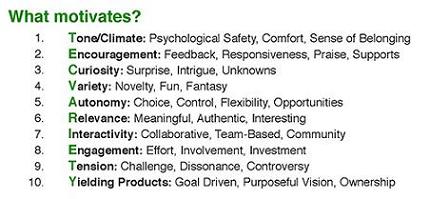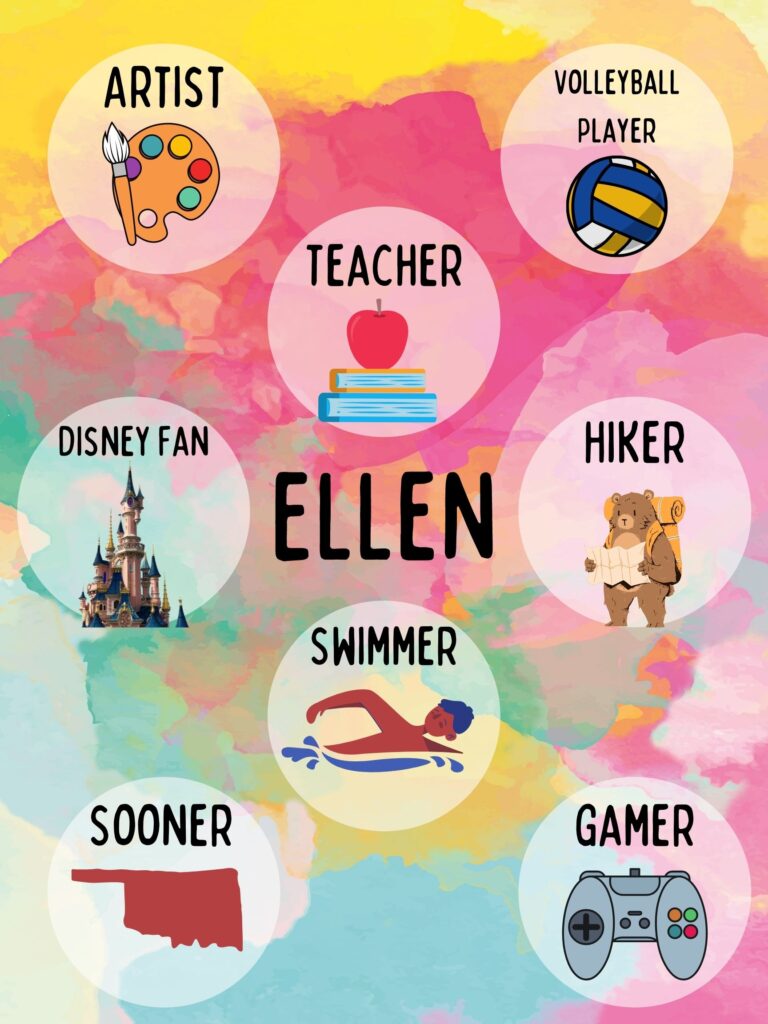
We have all be part of a community at some point in our lives. Whether it is a school-related community or a hobby-based community, we have places that we go to learn and engage with others. There are many elements that must be considered when forming a learning community, and the TEC-VARIETY framework helps us see a lot of what a community should ensure having, and how the community can motivate its members in participation.

Tone/Climate
When we discuss the tone/climate of a learning community, we refer to how the community makes the members feel. Do the members feel safe in this environment? Do they feel included? Do they feel like they have found a place they can truly belong? Thinking about my role as a teacher, I have a small-ish community of nine to ten-year-olds that I want to feel safe, comfortable, and know that they belong. These feelings of making a successful climate must come at the very beginning of the community’s formation. Concerning my classroom, we must build the tone from the very beginning; the beginning of the year when students first come into the classroom is the prime time to get the climate set.
Now, I have not had to teach in a fully virtual setting, but I have had a school year that started out virtual due to the Covid-19 pandemic. The beginning of my second year of teaching started out on Zoom, so it was important for me to start build build relationships with students and set the tone for what their third grade experience was going to be like with me as their teacher. While I have heard and read about all kinds of tone/climate setters for learning environments, I would be curious to poll teachers what activities they have found to be the most successful for them. I would think it could be harder to get the tone set if the learning environment was virtual, but after reading Bonk and Khoo’s take on digital activities that could be done, it gave me some hope and a more positive outlook that there could be something effective there.
One activity that I found interesting was the “Eight Nouns” activity. “In this task, everyone is required to post to a discussion forum eight nouns that best describe themselves. Learners should also describe why each particular noun selected is representative of who they are. Depending on the instruction preferences, such descriptions can be short, perhaps one or two sentences, or longer, extending for a paragraph or more” (Bonk & Khoo, 2014, pp. 55-56). I think this would be a great activity for students to allow them to describe themselves to their teacher and to fellow classmates; it gives everyone a chance to know a bit about the classmate before spending a lot of time with them. One way I think students could do this is by creating their own digital poster through Canva.

Canva is a great tool for visualization and for telling stories about any given topic, such as describing yourself to others. Students could use this tool to make a unique poster that describes themselves. If I were to implement this activity in a hybrid situation, I would introduce Canva and its capabilities on the first day the community (my class) meets together to know one another. I would give students a walk-through of how to use it, how to add pictures, change fonts, etc. Although that whole first week is used to get to know one another, the teacher could give the students a week to create a poster that includes eight nouns about themselves. They could add pictures on the poster they create to help further describe the nouns they chose. Depending on the teacher, students could write the sentences (like the TEC-VARIETY described) to help them explain each of the nouns. If I were to implement the activity, I would have students write at least two to three sentences about the noun they chose and how it ties in with their life. This would be a great way for students to get to know one another to build that sense of belonging, community, and finding friends who might share mutual interests and “nouns”.
An example of an “Eight Nouns” poster created in Canva might look something like this:

Encouragement
Having “Words of Affirmation” as my second top Love Language means that I feel really good about myself when I receive words of encouragement. It especially means that I feel especially “loved” when I receive those affirmations from people who play a big part in who I am. People in a community need encouragement and feedback in order to provide a sense of belonging in the community. It gives members the opportunity to grow in their own way to become more independent and valued members of their community. One way to make sure that members are heard and understood could be through a suggestion box; whether a physical box or online box, either one could be implemented.
Similar to that of a “My Teacher Should Know….” jar in a classroom, a suggestion box could be used by an instructor to allow students to be heard without feeling called out. If I were to implement such an activity to provide encouragement virtually, I would use Google Forms to create a survey of sorts that asks allows learners to submit an anonymous form (giving the form a name could be optional if the learner desires). I would leave this Google form open throughout the entire year to allow students to have “a sense of power and control over unclear assignments, areas of the course that they believe could be improved, and any dilemmas or frustrations that they are experiencing” (Bonk & Khoo, 2014, pp. 76). Students could share any thoughts, opinions, feelings, etc. that they are feeling throughout the school year; that way I can check in with students without making them feel obligated to come to me face-to-face. If I had been offered this opportunity as a student to share how I am feeling with my teacher without feeling forced to talk straight to them, I think I would have grown in confidence towards my academics. Too many times, I was scared to approach a teacher due to not wanting to look stupid or silly for asking/feeling certain ways toward the content.

Autonomy
I have to give Bonk and Khoo props for a great many things, but I love the fact that they used Harrison Ford’s quote “To me, success is choice and opportunity.” Harrison Ford is one of my all-time favorite actors, and that quote just helps boost my love for him. I totally agree with this statement because everyone is capable of some type of success; it’s a matter of taking the opportunity and making the choice to aim for that success. While some teachers may faint at the option of giving students too much choice in their education, it can be something that is used to a wise degree. Teachers have this fear because, especially considering the age-level of some students, you never know what kind of opportunities they’d take with this “freedom” in their hands. There still has to be some form of structure behind that freedom. The Starter-Wrapper Technique from the TEC-VARIETY book is a great way to allow for freedom in choosing while also staying on the academic side.
“When using this technique, students sign up to lead or end the discussion on the assigned book chapters, articles, videos, and other resources for any week that interests them. The discussion takes place in designated threads in an asynchronous discussion forum. Most learners find a week that interests them. Students can also sign up in teams or in tracks” (Bonk & Khoo, 2014, pp. 143). While this strategy might be more common with older grade levels, such as middle school and upward, I think this strategy could be used in the elementary level if implemented appropriately. I think it is a great activity that can build a sense of leadership by allowing students to take over leading discussions and activities; giving them a sense of ownership for helping students understand information.

Questions I have:
- Aside from the fear I mentioned in my post, why do you think some teachers fear the idea of “student choice” being implemented in their classroom?
- As I was reading and picking activities to build up encouragement and autonomy, I noticed that I kept merging the two together on accident when choosing activities to build them up. Are the two always interlocked, and that might be why I get them mixed together? Or am I just being silly and not seeing a clear divide between the two?
References:
Bonk, C. and Khoo, E. (2014) Adding some TEC-VARIETY: 100+ activities for motivating and retaining learners online (pp. 45-90, pp. 137-155). Open World Books.
Huiting Zhou
April 13, 2022 — 1:43 AM
Hi Ellen,
I really enjoy reading your blog! Because it always provides me with a plethora of fascinating insights. I enjoyed the “Eight Nouns” activity as much as you did, and you paired it with Canva to make a poster example, which is quite lovely! To answer your question, I believe some teachers are concerned of offering pupils too many choices because they don’t plan ahead of time for what can happen. This forces teachers to consider many scenarios and reactions, which can be a challenging task. To be honest, I feel the 10 principles presented in the book are all related and articulated, so it’s hard to distinguish exactly one of them, and that’s what bothers me. Anyway, good job!
Walter
April 13, 2022 — 2:21 PM
Hey nice quote to start off the blog! Really enjoyed your blog post, and I always appreciate seeing your experiences utilizing some of these in a third-grade online environment. I was thinking about your question regarding autonomy and encouragement and their link. I think I’ve never connected them in my own brain so strongly, so it’s been interesting. Do you suppose it’s maybe that granting someone autonomy provides a dopamine rush in the same way encouraging them does, and so the feeling is similar? I also think that granting someone autonomy requires a lot more encouragement to keep them going: the fewer boundaries in place, the harder to know your progress, so to speak. Do you see them as similar in how they’re cultivated or similar in how they’re experienced? If that’s even a meaningful distinction :/
Xun Ge
April 14, 2022 — 12:02 PM
I really like Walter’s explanation about the relationship between autonomy and encouragement. Well done!
Amanda
April 13, 2022 — 7:29 PM
I love the Canva poster take on the 8 nouns introduction, plus the extended time frame to allow them to really reflect and make it more meaningful.
The Einstein quote was my favorite 😉
I think that too much autonomy can sometimes feel like more “work”. Not to imply that they are avoiding work, but when you are already feeling overwhelmed the ideas of tracking everyone’s different approaches might feel like a bit too much.
Nida
April 14, 2022 — 10:04 AM
Hello Ellen!
I really appreciate the way you manage your detailed analyses. I get so inspired. The content becomes more understandable after reading your responses. I really appreciate the way you started zoom classes and took initiative to facilitate students by all means. I think you decided well about consulting other teachers, the activities they perform and how they engage students could be helpful for you. Coming towards the activity named Eight nouns. I think you quoted well about providing an explanation in a paragraph instead of just writing eight nouns to describe oneself. When I went through the readings and came across this activity, I really liked the concept but I was thinking, why should it be eight, what was the reason behind choosing this number. Students could introduce themselves in less or more than eight nouns. Anyway, I do like this concept and I used to adopt this kind of methodology in my classrooms back in Pakistan but at that time, I did not know that this activity actually had a name. What I used to do is that whenever a new class came in, I asked them to describe themselves in 3 to 4 sentences. Sometimes this description was in 5 to 6 words. I think students find it interesting and introduce themselves happily. I have one question for you Ellen. What major difficulties did you face when you had to join all classes online and there was Covid all over. I would really like to know about your experiences. Great post. Thank you so much for such detailed analysis.
Yuchen Li
April 26, 2022 — 2:07 PM
Hey Ellen, I think the reason teachers are afraid to try out student choice ideas in the classroom may also lie in a fear of losing authority. As you said, as a teacher, you never know what kind of things or questions students will use that autonomy to do or ask. I remember my instructor telling me not to ask students questions in class that I have a hard time grasping the answer to, and to make sure that the student’s answer always falls within my area of knowledge. So I think this fear comes from the teacher’s lack of preparation for the course. What we need to continue with students is a sense of autonomy that meets the learning objectives after we design it, not an autonomous exploration without limits. I’m not opposed to, in fact, I’m very much in favor of, “unrestricted” independent exploration and learning, but relative restraint in the classroom is also necessary.